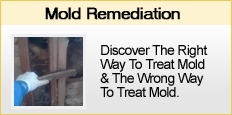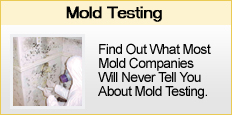Mold Inspections
 |
 |
 |
Mold Inspections in New Jersey
The Right Way to do a Mold Inspection VS The Wrong Way
We’ve heard many horror stories about non-qualified “mold inspectors” doing mold inspections the wrong way. Most of the time, these are general contractors posing as mold inspectors which is highly unethical. Mold inspections require a trained eye, and even with appropriate certifications & equipment, it takes years of experience to become a professional mold inspector.
If you are looking for a mold inspection in New Jersey, it is extremely important to understand a few basic concepts. We get asked many of these questions on a daily basis, so we have devised a FAQ in order to serve our clients better.
What Type of Equipment Should A Mold Inspector Carry?
1) Moisture Meter – A moisture meter is a mold inspectors best friend. These handy little tools can measure how much moisture is on any given surface. And since mold needs moisture to grow, every mold inspector is required to carry and use a moisture meter to detect “hot spots” for mold.
A well trained mold inspector will use his moisture meter as often as a mechanic uses his wrench. So if your mold inspector does not carry a moisture meter, or only uses it a couple of times, politely request that they leave the premises asap. A well trained mold inspector will use his moisture meter usually between 10-30 times. This is the trademark of any well trained mold inspector.
2) Flashlight – Regardless of how much light is in any given area, a flashlight can be used to reveal hidden mold colonies using a specific technique. The goal is to shut all the lights off in your home, and tilt the flashlight in a variety of specific angles. We have discovered that mold will tend to grow towards light sources, and certain strains of white mold can appear 100% transparent / invisible in normal lighting conditions. But once the angle of the light source is changed, you can expose these massive colonies of mold and surprise the hell out of a homeowner.
We have a video of one of our mold inspectors using this technique here.
3) RH Detector or a Barometer – Mold does not always need a wet surface to grow on. Bad ventilation can lead to pockets of high humidity in certain areas of a home (ie. lower corners of a basement). An RH detector or barometer can detect unnatural variations in humidity that can create the perfect conditions for mold growth. So a well trained mold inspector will use an RH detector or recommend installing barometers in your home to record humidity levels.
4) Boroscope – A boroscope is a great non-intrusive way to inspect behind sheetrock walls, insulation, and any other areas that are not so readily accessible. They allow a mold inspector to drill a tiny hole in your walls or ceilings, rather than cutting down large pieces to access these areas. If you have mold contaminated sheetrock in your basement, or ceilings, a mold inspector is required to look behind these areas. Whether they cut out sheetrock or use a boroscope, a properly trained mold inspector will always inspector hard to reach areas.
5) Sampling Protocol – Sampling is not always required, but any experienced mold inspector will carry a variety of sampling equipment such as tape, swabs and air-o-cells for testing air. They should also understand when and why to use a specific protocol over another. For example, if they are taking samples from a carpet, and using a swab, that is the wrong way to test a carpet. Tape should always be used on carpets and other flat surfaces, swabs are typically used on hard to reach areas like vents, fans, interior walls, underneath carpets etc etc.
___________________________________________________________________________________
Is There Any Type of Equipment That Shouldn’t Be Used During a Mold Inspection?
Yes, believe it or not, there is a lot of equipment that mold inspectors will show up with just to dazzle a homeowner or create the perception of a premium quality service. They believe these unethical techniques will impress a homeowner when in reality these tools have absolutely no use during a mold inspection.
1) Particle Counters – Particle counters are expensive little tools that can count the amount and size of microscopic particles in the air. However, 99% of mold certification labs recommend against using these tools during a mold inspection. And the reason why is fairly simple. These tools can and do detect particles in the air, the problem is, they can only detect large particulates like skin, dander, pollen and dust.
To compound this problem, these particle counters can not go under 3 microns in size, and 90% of mold spores are under this range. These counters give you very general representations of what is in the air, and can roughly determine the large micron particulates. Yet even with large particulates, these instruments are well known for being highly inaccurate. So how can they be reliable for identifying mold? The answer is they can not! In the end, all you have is a scary, unfamiliar, inaccurate representation of black dots all over a gray screen. Which makes the perfect tool for any unethical mold inspector to scare the crap out of a homeowner!
2) Digital Microscopes – In essence, microscopes are the most useful tools for determining the type, quantity and toxicity of mold. The problem is, it takes a specially trained microbial biologist to properly use a microscope. And they should only be used in a controlled enviroment (lab) after proper sampling has been done by a certified mold inspector. It also takes a very specific type of microscope to properly identify mold (electron microscope), and there is no way to bring these microscopes inside a home. They are far too large, they rely on state of the art computer technology, and once they leave a controlled environment they are subject to all sorts of problems.
Furthermore, many strains of mold are nearly identical to other strains under a digital microscope. So if a mold inspector whips out a microscope in effort to impress you… please, do not be impressed! The reality is, once mold samples are sent to a lab, a lab will culture the samples before the testing process even begins. And this is something that takes 3-5 days to do in a controlled environment… so how can you expect a mold inspector to pull this off?
The simple answer is you can’t.

